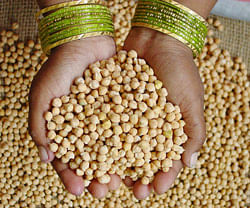Scientists have mapped the genome of chickpea, which may lead to the development of high-yielding varieties of this food legume consumed widely in India.
The genome mapping by a team of 23 academic institutes including three Indian farm research centres and Hyderabad-based International Crop Research Institute for Semi-Arid Tropics (ICRISAT) has led to discovery of 28,269 genes in the chickpea genome, some of which can be exploited to develop improved varieties.
“Currently chickpea yield is stagnated between 700-900 kg per hectare. But it can go quite high. Proper identification of genes from the genome map may lead to faster breeding of new varieties,” Swapan Kumar Datta, deputy director general (crop sciences) at the Indian Council of Agriculture Research and one of team members told Deccan Herald.
Chickpea (Cicer arietinum) is the world's second most widely grown legume crop after soybean, accounting for a substantial proportion of human dietary nitrogen intake.
With more than 85 lakh tonnes of annual production, India is the world's highest producer of chickpea that supplies protein to the poor.
The candidate genes were identified after the draft genome sequence was compared with known genes from 90 cultivated and wild types of chickpeas from 10 countries.
“The genetic diversity of chickpea is so narrow from other legume species, we could not undertake any crop development programme for chickpea. The new knowledge would help in creating better varieties either by the molecular breeding or transgenic route,” Datta said.
In India though the area under chickpea increased from 6.45 million ha in 1992-93 to 8.56 million ha in 2009-10 with Madhya Pradesh, Uttar Pradesh, Rajasthan, Maharashtra, Gujarat, Andhra Pradesh and Karnataka accounting for 95 per cent area, India still imports chickpea from Australia and Canada to meet the growing national demand.
In much of the world, chickpea is cultivated in semi-arid environments and on soils of poor agricultural quality.
Combined with its susceptibility to drought and debilitating fungal diseases this have restricted yields to less than one ton per ha, which is considerably below the theoretical potential, the team reported in January 27 issue of Nature Biotechnology.
The draft genome sequence of a Canadian kabuli chickpea variety, widely cultivated and resistant to several important fungal diseases, including Ascochyta blight, and insects like pod borer will eventually aid in improving the livelihood and productivity of chickpea farmers particularly in the resource-poor environments of sub-Saharan Africa and Southeast Asia.
"As majority of chickpea production is done in semi-arid tropic regions, we have major emphasis to improve drought tolerance in chickpea. We would like to have higher yield under drought conditions We are in process of developing superior lines through molecular breeding," said RajivVarshney, lead author of the paper from ICRISAT. The scientiss may also look at improving the plant architecture so that they can be harvested mechanically.
Apart from ICRISAT, other Indian institutes in the team was Indian Agriculture Research Institute and National Bureau of Plant Genetic Resources, both in Delhi, and Indian Institute of Pulses Research in Kanpur.
This is the second food legume genome sequenced in India after pigeon pea.

